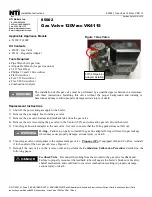
3
The Ø100-mm flue pipe from the pellet boiler to the chimney should have the following characteristics:
Total length maximum 5 m (in the case of a larger connection, increase the diameter of the connecting pipe to Ø150
mm),
Each knee of 90˚ reduces the total length of the flue pipe by 1 m, which means that if you have one knee, the total
length can be 4 m, two knees 3 m, etc.
The cap needed for cleaning should be located on each knee;
The connections between the pipes should be sealed.
If there is excessive resistance in the smoke discharge system (numerous knees, inadequate endings, bottlenecks,
etc.), the discharge of flue gases is not guaranteed and the connection pipes and knees should have larger dimensions – Ø150
mm. Similarly, in case the chimney does not allow proper flue gas discharge, there may be an irregularity in operation and,
consequently, the Como Compact 32 Boiler alarm may be activated. It is recommended that the chimney is checked by a
qualified person before installing the Commo Compact 32 Boiler .
The system for discharging smoke from the pellet boiler operates thanks to the underpressure that occurs in the
combustion chamber and barely noticeable pressure in the flue pipe Ø100 mm. Therefore, make sure that the flue pipe is
completely sealed.
It is necessary to carefully analyse the position and condition of the space through which the chimney passes. If the
flue pipe passes through the wall and/or roof, it should be properly insulated in accordance with fire safety regulations.
Make sure that there is sufficient combustion air in the room where the boiler is located. The air supply pipe should
have at least a 110-mm diameter and it should not be longer than 10 m. For each knee of 90˚, the maximum length is reduced
by 1 m. If the pipe is too long, it is necessary to increase the diameter of the air supply pipe.
If a grid is placed on the facade, the air inlet opening should be at least 100 cm
2
or bigger. The boiler operates at 220-
230 V – 50 Hz. Ensure that the electrical cables do not go under the boiler , that they are away from hot surfaces and that they
cannot come in contact with any sharp objects that could damage them. If the boiler is electrically overloaded, this may
significantly shorten the service life of the electrical components of the boiler .
Never turn off the power supply by pulling out the plug while there is still flame in the boiler . This may damage the
boiler seriously and jeopardize the proper operation of the boiler .
AIR SUPPLY
The combustion air must be supplied to the room with the boiler. The room must be continuously aired.
The fresh air opening must be at the bottom of the room and must let in the air.
A) Combustion air supply by pipeline through basements. This connection option preheats the combustion air, which is
useful for good and clean combustion. Installation of pipelines in the basement is simple.
B) Combustion air supply through basements. The combustion air is preheated. The basement space must be separated
from the ventilation system of the house and open to the outside. Avoid high levels of dust and moisture.
V) Combustion air supply from above. Air supply from above can only be performed with tested flue systems.
In this case, you must calculate the dimensioning of the flue!
D) Combustion air supply directly from outside. If the air is supplied directly through the outer wall, the combustion air is
only slightly preheated, which is unfavorable for clean combustion. In this case, there is also a risk of condensation!
NOTE: We do not recommend these versions of the air supply! However, if you use these options, consult a qualified
professional.
The room with the heating appliance must have a sufficient supply of fresh air. If the windows and doors are hermetically
sealed or there are air extracting devices such as a hoods, hair dryers, fans, etc. located in the room with the boiler,
combustion air (fresh air) must be supplied from outside. In any case, this should be discussed with the competent
chimneysweeper before installing the boiler.








































